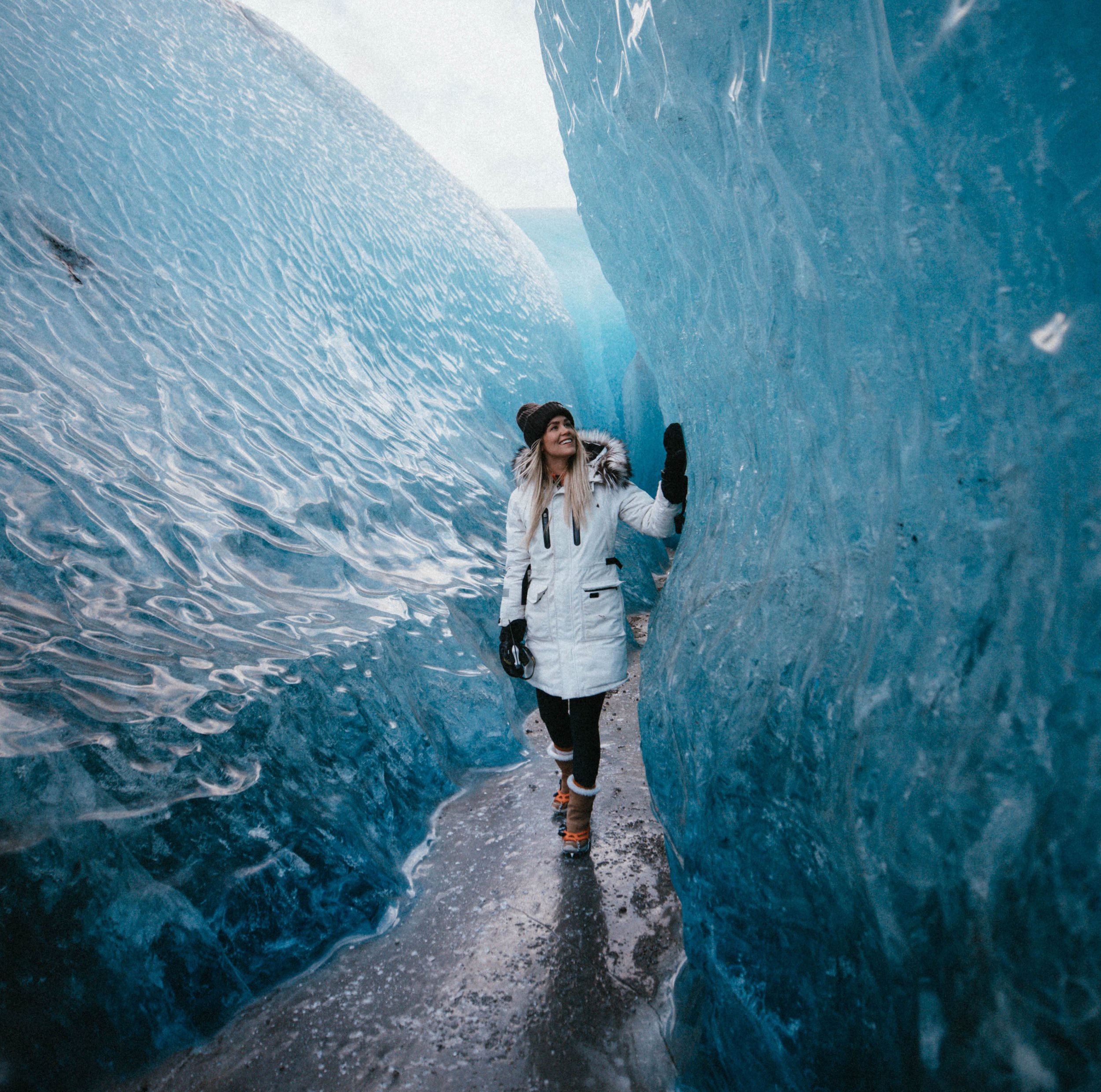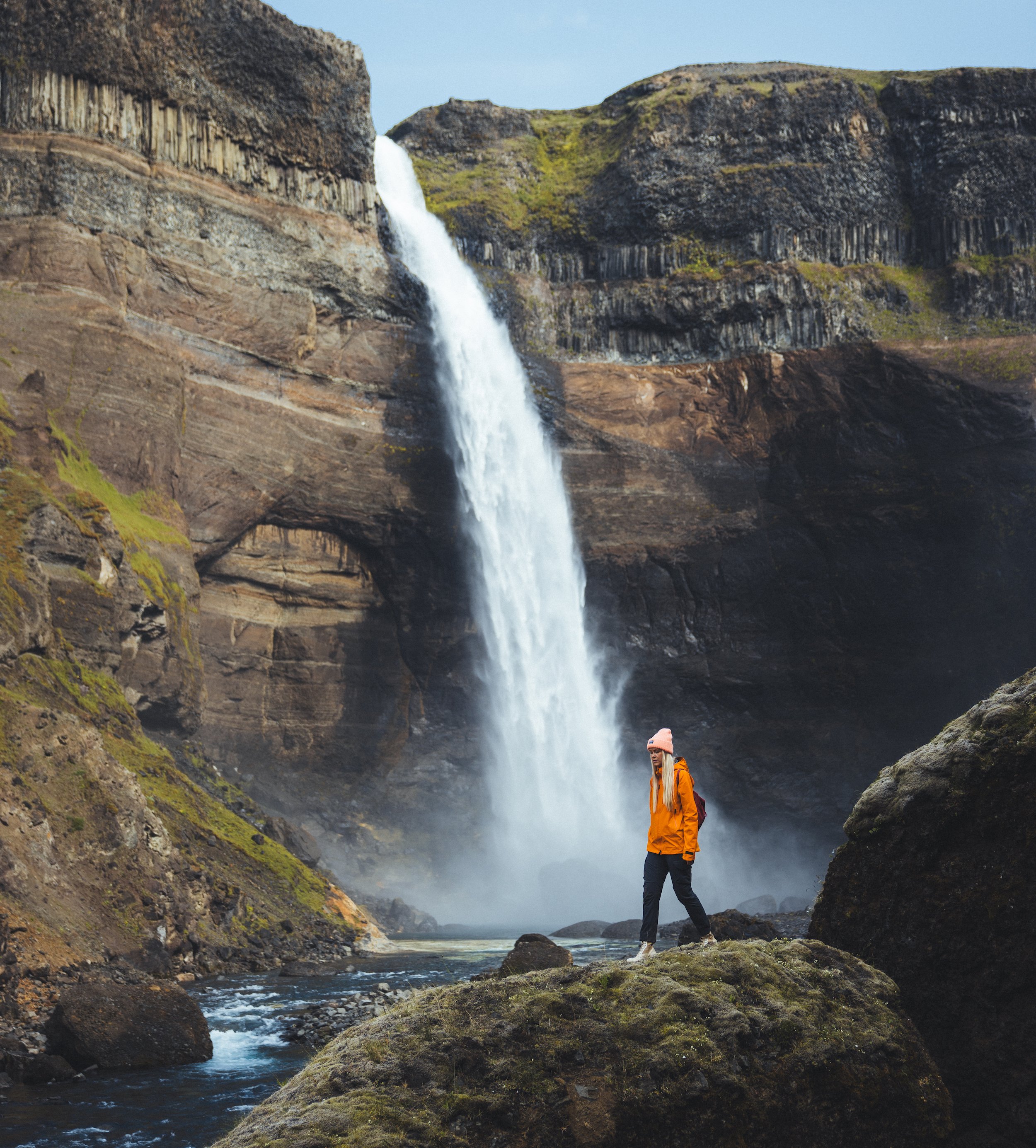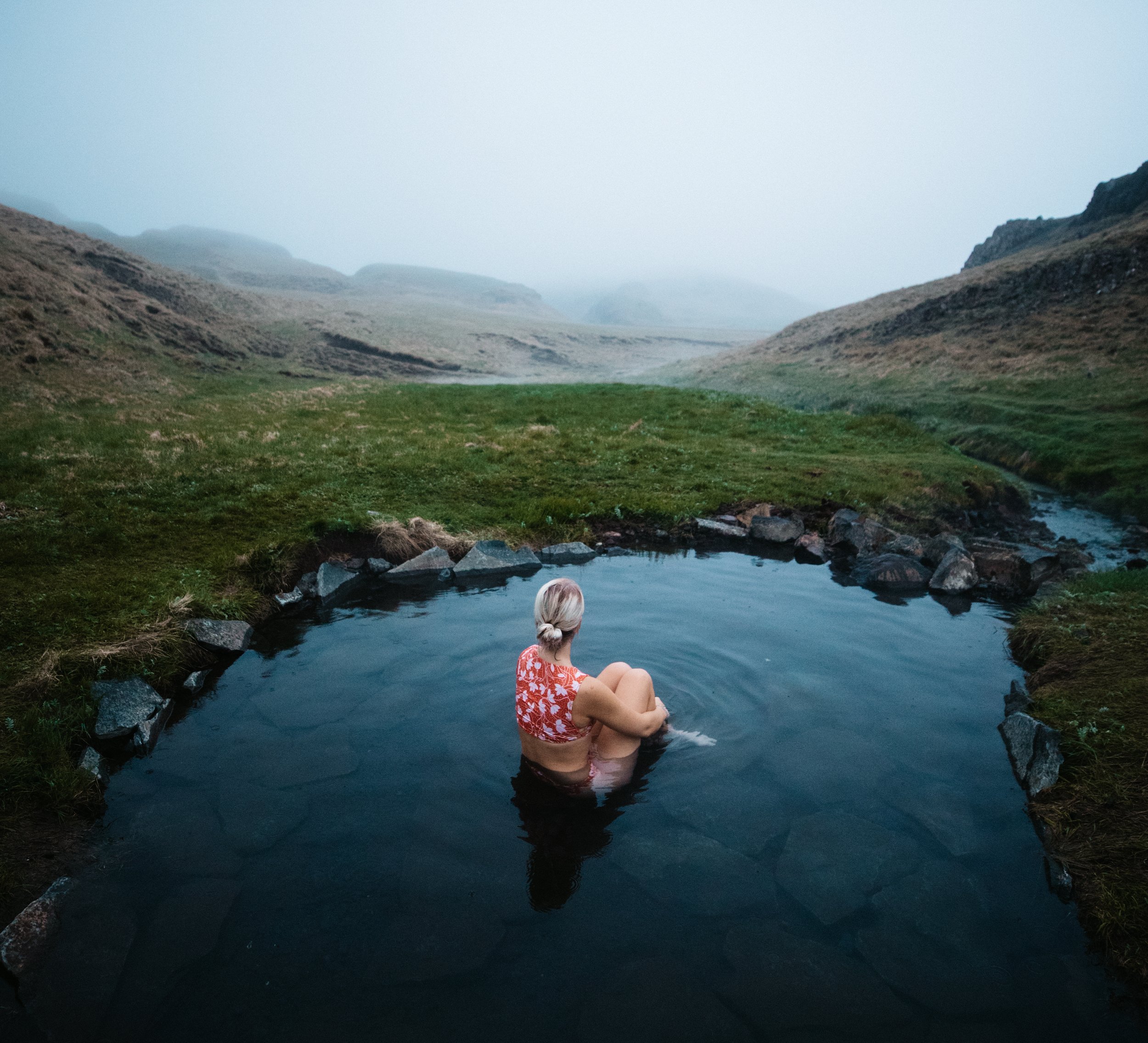What to pack for Iceland (by season)
Wondering what you’ll need to bring to Iceland?
With its diverse landscapes, experiences, weather, and terrain, one of the most important things to do for an enjoyable time in Iceland is to have the right gear! Whether you’re traveling the Ring Road, staying in Reykjavik, vanlifing around Iceland, or heading out on a guided tour, check out my packing lists below to help you prepare.
Year-Round
Sandals - if you’ll be visiting the hot springs you’ll probably want something else to keep your feet happy other than your hiking boots.
Swimsuit - important for the hot springs! Some spas offer swimsuits for rent in case you forget yours.
Towel - a quick-dry, thin, microfiber towel will come in handy when visiting natural hot springs and will save you a few bucks at some spas which charge for towels.
Personal Water Bottle - Always stay hydrated and avoid single use plastic. You can fill up in all taps and most rivers in Iceland!
Power adapter and/or converter - Iceland has standard European outlets (two rounded prongs). If your electronics do not have the same prongs you’ll need an adapter at the very least. An adapter only allows for different shaped prongs to plug in. If you’ll be bringing electronics suited for 110 - 120 volts ONLY (ie - North American hair dryers, curling irons) then you’ll need a converter. Always check your devices before plugging them in. Some hotels have USB ports which don’t require an adapter or converter. Your rental car will likely have a USB port as well.
Drivers license - most rental car companies do NOT require an international drivers license but be sure to bring your license if you’re renting a car or van.
Passport - ESSENTIAL! And, make sure your passport will not expire more than 6 months after your scheduled return date. Passports expiring sooner than that may cause problems at the passport control/immigration desk in the airport.
Charging cables
Waterproof phone case - a simple waterproof pouch to carry your phone in the hot springs and lagoons will allow you to take photos of the gorgeous scenery without worrying about your phone getting wet. This can also be handy if you’re exploring in the rain.
Personal items - toiletries, medications, glasses, etc. Consider bringing your own pain relievers and cold medicines as well. Pharmacy hours are limited and some common health issues will require a prescription. Many hotels have soaps and shampoo but it’s not always reliable.
Sunglasses - if you’re anything like me, you’ll be driving a lot in Iceland! Sunglasses will be your best friend no matter the season!
Winter (November - March)
Iceland in the winter is ICY! Of course you’ll need to be prepared with warm layers including a hat and gloves and you’re an avid winter sports person, you should already be familiar with many of these items. However, if you believe that you’ll only need winter gear for your trip to Iceland and won’t ever use it again, consider renting gear from IcelandCover Outdoor Clothing Rental or Iceland Camping Equipment Rental (both based in Reykjavik).
Coat/parka - it’s important to stay warm and dry, so bring a good jacket. Waterproof/weatherproof with an adjustable hood and sleeves is great. And, the longer the better.
Pants - both insulated ski/snow pants or waterproof hiking pants work great. Think of your pants as your jacket for your legs - warm and dry. (I do not recommend wearing jeans unless the weather is nice or you’ll be indoors)
Warm mid-layer - dress like the locals in an Icelandic wool sweater or a comfy sweatshirt. Try to stay away from cotton though as it doesn’t dry very quickly. Keep in mind that you’ll likely be dining and doing indoor activities with your mid-layer exposed. For exceptionally cold and windy days, fleece leggings work great between your base-layer and waterproof pants.
Thermal base-layer - opt for quick drying, non-cotton, thin & warm shirt and leggings. Active wear/long-sleeved workout gear is often a good choice.
Beanie
Gloves - warm, windproof & waterproof. If they have touch screen capability, that’s even better.
Socks - wool hiking socks, calf-length or higher. Compression socks can be great too for the plane ride over and if your feet tend to swell when standing or walking for long periods of time.
Scarf or balaclava - sometimes you’ll want everything but your eyes covered so a scarf or balaclava helps cover whatever your coat misses.
Microspikes/crampons/Yaktrax - highly recommended but often forgotten for winter trips to Iceland. You’ll find that many walking paths and trails, no matter how heavily trafficked, can be packed with ice and snow. Microspikes will help you traverse the ice with more confidence and fewer falls.
Hiking boots - proper hiking boots that are waterproof and have good traction are essential. Choose boots with good ankle support, especially if you’ll be doing more than the main sights.
Snow Boots - use these for walking in DEEP snow or if your hiking boots aren’t keeping your feet warm.
Spring (April & May)
The beginning of April is still pretty much winter in Iceland but the days are getting longer and longer and the snow is starting to melt. This means muddy trails so good waterproof boots are more important than ever. If you’re coming at the beginning of April err on the side of warmth. If you’re coming at the end of May, you can get away with fewer and lighter layers.
Jacket/Coat - it’s important to stay warm and dry, so bring a good jacket with a light but warm lining. Waterproof/weatherproof with an adjustable hood and sleeves is great.
Pants - waterproof hiking pants work great. Think of your pants as your jacket for your legs - the main goal is to stay dry.
Warm mid-layer - dress like the locals in an Icelandic wool sweater or a comfy sweatshirt. Try to stay away from cotton though as it doesn’t dry very quickly. Keep in mind that you’ll likely be dining and doing indoor activities with your mid-layer exposed. For exceptionally cold and windy days, fleece leggings work great between your base-layer and waterproof pants.
Thermal base-layer - opt for quick drying, non-cotton, thin & warm shirt and leggings. Active wear/long-sleeved workout gear is often a good choice.
Beanie
Gloves - warm, windproof & waterproof. If they have touch screen capability, that’s even better.
Socks - wool socks will help to keep your feet dry. Or, opt for compression socks which can be great for the plane ride over and if your feet tend to swell when standing or walking for long periods of time.
Scarf or balaclava - sometimes you’ll want everything but your eyes covered so a scarf or balaclava helps cover whatever your coat misses.
Hiking shoes/boots - proper hiking shoes or boots that are waterproof and have good traction are essential. Choose boots with good ankle support, especially if you’ll be doing more than the main sights.
Sneakers or casual shoes - having an alternative shoe to wear when you’re driving, shopping, or walking in the city will be really nice.
Netted hat - you’ll look so silly but everyone who doesn’t have one will be jealous. Biting midges are abundant around the lakes in May and June, especially in Mývatn (North Iceland) and a netted hat will allow you to still enjoy the area without the nuisance.
Summer (June - August)
Summer in Iceland does NOT mean relaxing on the black sand beach in your tiniest bikini. But, you’ll have the best weather Iceland has to offer and you may even get by with a t-shirt! However, it can still be rainy and windy so you’ll still need to be prepared to stay warm and dry.
Jacket - bring a lightweight or lightly lined waterproof jacket. A hooded jacket is extra handy and be sure it isn’t too tight - you’ll still need to have a layer or two underneath.
Pants - waterproof hiking pants work great. Think of your pants as your jacket for your legs - the main goal is to stay dry.
Mid-layer - light sweaters, cardigans, or sweatshirts
Base-layer - opt for quick drying, non-cotton, thin shirt and leggings. Active wear/ workout gear is often a good choice.
Beanie - yes, the summer wind can still make you shiver! Bring a beanie to help control heat loss and your hair!
Socks - thinner wool socks will help to keep your feet dry. Or, opt for compression socks which can be great for the plane ride over and if your feet tend to swell when standing or walking for long periods of time.
Hiking shoes/boots - proper hiking shoes or boots that are waterproof and have good traction are essential. Choose boots with good ankle support, especially if you’ll be doing more than the main sights.
Sneakers or casual shoes - having an alternative shoe to wear when you’re driving, shopping, or walking in the city will be really nice.
Jeans or casual leg wear - for going to restaurants, walking around the city on a dry day, etc.
Netted hat - you’ll look so silly but everyone who doesn’t have one will be jealous. Biting midges are abundant around the lakes in May and June, especially in Mývatn (North Iceland) and a netted hat will allow you to still enjoy the area without the nuisance.
Sleeping eye mask - summer in Iceland is BRIGHT! On the longest day of the year there is less than 3 hours of “darkness”. Bring a sleep mask to help you get a good night’s rest!
Autumn (September - October)
The autumn colors of Iceland are stunning and it’s a wonderful season to visit. Although the days are getting shorter there are still plenty of awesome things to do and see. Be aware that autumn storms can often be just as severe as winter storms so come prepared for a variety of weather conditions.
Jacket/Coat - it’s important to stay warm and dry, so bring a good jacket with a light but warm lining. Waterproof/weatherproof with an adjustable hood and sleeves is great.
Pants - waterproof hiking pants work great. Think of your pants as your jacket for your legs - the main goal is to stay dry.
Warm mid-layer - dress like the locals in an Icelandic wool sweater or a comfy sweatshirt. Try to stay away from cotton though as it doesn’t dry very quickly. Keep in mind that you’ll likely be dining and doing indoor activities with your mid-layer exposed. For exceptionally cold and windy days, fleece leggings work great between your base-layer and waterproof pants.
Thermal base-layer - opt for quick drying, non-cotton, thin & warm shirt and leggings. Active wear/long-sleeved workout gear is often a good choice.
Beanie
Gloves - warm, windproof & waterproof. If they have touch screen capability, that’s even better.
Socks - wool socks will help to keep your feet dry. Or, opt for compression socks which can be great for the plane ride over and if your feet tend to swell when standing or walking for long periods of time.
Scarf or balaclava - sometimes you’ll want everything but your eyes covered so a scarf or balaclava helps cover whatever your coat misses.
Hiking shoes/boots - proper hiking shoes or boots that are waterproof and have good traction are essential. Choose boots with good ankle support, especially if you’ll be doing more than the main sights.
Sneakers or casual shoes - having an alternative shoe to wear when you’re driving, shopping, or walking in the city will be really nice.
Optional
If you have these items already and/or you have room in your luggage consider bringing this stuff too.
Rain suit (pants & jacket) - a lightweight, easily packable rain suit like Frogg Toggs can be really helpful for really wet weather and walking behind waterfalls (hello, Seljalandsfoss)! A rain suit is most useful in the warmer months.
Walking poles - on proper hikes, especially those that are steep like Hengifoss and Svartifoss, walking poles can be super helpful in limiting the strain put on your joints.
Cash - almost every place in Iceland accepts payment via credit card. However, there are some hot springs and hiking areas that operate on the “honesty system”. Having cash will be helpful for those times. And, you can spend your leftover cash at the airport or bring it home as a souvenir. You can easily get some cash at the ATMs near baggage claim at the airport but be aware of your bank’s fees.
Portable device charger - having an option to charge your devices on the go will help you stay connected and able to take photos all day long. This will be especially helpful in the colder months when devices tend to lose their charge quickly.
Extra bag - something as simple as a reusable grocery bag or a packable duffel bag will help you stay organized. Use it as a pantry for vanlifing, a dirty clothes hamper, or as extra luggage to hold your souvenirs on your way home.
Selfie-stick or tri-pod - having a way to take photos in a variety of compositions in the most remote locations is great for capturing all of your experiences in unique ways.
The key takeaway regardless of which season you’ll be visiting Iceland is WATERPROOF and WINDPROOF. Much of your time in Iceland will be spent outdoors and since Iceland’s weather is notoriously wet and windy, you’ll be grateful to have gear that keeps you comfortable in unfavorable conditions. With the right gear (especially your outer layer) you’ll be able to explore in the rain, snow, wind, and the occasional sunshine.






